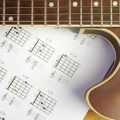When I got my first job in Seattle working as a busboy at a busy restaurant, I would often ask the chefs working with me for tips on how to cook. “How do you cook salmon?,” I naively asked a stressed out chef one day. “There’s literally thousands of answers to that question,” the surly chef replied before turning away to mince some garlic. When it comes to the subject of exploring different guitar playing styles, it’s similar to cooking salmon in the fact that there’s an overwhelming amount of history, nuance and unique characteristics that can be heard and learned within each style’s genre. In this article, I’ll discuss and explore some of the more prominent and influential guitar playing styles found in popular music’s past and present.
Where did the modern guitar come from?
If we want to properly understand guitar genres like blues, rock and jazz, we should learn what the guitar actually is and where it came from. These days, the guitar is as commonplace as anything you’re likely to find in a person’s home, but even the most serious guitarists don’t usually bother to ask where the heck this amazing instrument came from.

According to the Metropolitan Museum of Art, “The beginnings of the European guitar are unknown. Scholars disagree as to whether the guitar, like the lute, was introduced to medieval Europe from the Middle East, or if it was indigenous to Europe. It is impossible to establish the history of the guitar before the Renaissance, but there are some much earlier plucked-string instruments which are related to later guitars either in physical form or playing technique.”
Long before the birth of modern guitars there were crude predecessor instruments that appear to have paved the way for guitars as we know them today. Instruments dating all the way back to 3500 B.C. called “bowl harps” were built from suspending strings from a long, narrow stick down to a hollowed-out gourd.
Thousands of years later, acoustic, electric and classical guitars are unavoidable within popular culture. It’s safe to say that the guitar is the most popular instrument in the world, and rhythm and lead guitar playing is now found in virtually every genre of music.
How the guitar came to America and came to dominate popular music
A version of the guitar made its way to North America during the 16th century by way of early Spanish explorers and missionaries. These early guitars were combinations of simple peasant instruments that also shared characteristics of the viola de amo, which was an instrument favored by the noble class in Spanish society. The English brought over their version of the guitar called the cittern during the 18th century. Citterns were extremely popular and they were even owned by towering historical figures like Benjamin Franklin and Thomas Jefferson.
Acoustic guitars as we know them today were developed in America during the 1830’s by European immigrants. Instrument makers didn’t start attempting to amplify the guitar’s sound until the 1920’s when bands were looking for ways to play loud enough to be heard by large dancehall crowds. The first electric magnetic pickup was invented by George Beauchamp and Adolph Rickenbacker in 1931, and the guitarists of a myriad of genres began playing the newly invented electric guitar soon after.

Photo credit: Christian Bertand / Shutterstock.com
The electric guitar allowed musicians to explore new tones, sounds and effects, and entire genres like rock and roll were built off of the instrument’s unique and driving sound. In 2017, the guitar is more popular than ever due to its portability, approachability for beginners and versatile sound. New sound technology being ushered in by effects pedals are giving guitarists a seemingly infinite tapestry of sounds and textures to work with, and fresh and interesting music is being written on and for the instrument every day.
Now that you know more about where this amazing instrument came from and how it was developed, let’s talk about some of the more important guitar playing styles being explored today.
Blues
It’s impossible to bring up guitar playing styles without talking about the blues. The blues has had an indelible impact on not just guitar music but all music heard within popular culture today. Much more than a playing style, blues music essentially provided the blueprints for the songs we’ve all heard and loved in music over the past century.
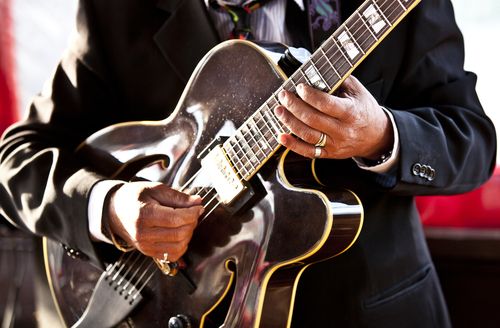
Blues music originated over a century ago in the Mississippi delta region in the American south. It was traditionally thought of as the music of longing, pain and dissatisfaction, and the lyrical content of the music is matched by the genre’s unique sound which is built off progressions of dominant seventh chords that never fully resolve.
Here’s an example of dominant chords in a song form called the 12-bar blues. Most blues songs feature a variation of this chord progression.
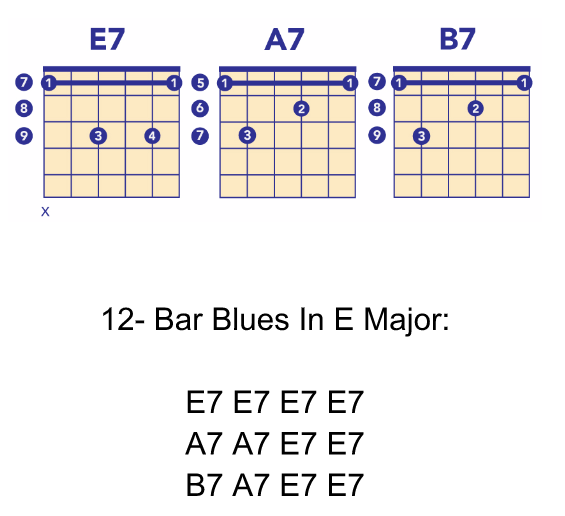
The blues playing style makes use of “blue notes” in scales. Blue notes are lowered third, fifth and seventh scale degrees. Scales with these notes are usually known as blues scales. Blues guitarists use blues and pentatonic scales to create lyrical, ornate solos in songs. Here’s an example of a blues scale that a guitarist would use to improvise or write riffs and solos with:
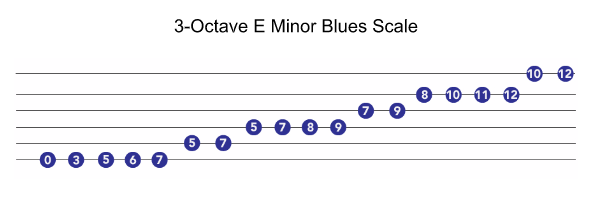
Guitar playing styles like the blues sometimes feature strumming patterns that are swung rather than played straight. Straight eighth notes are played precisely on and between beats, but swung eighth notes stray from that formula. It’s easier to understand swung rhythms by listening to them instead of reading about them. They’re sequences of long and short notes played back to back that repeat throughout a song. The sound of swung rhythms is something akin to to sound of a horse galloping in slow motion.
Rhythm guitarists use straight and swung strumming patterns to play simple, repetitive chord progressions. Life might seem sort of boring for a rhythm blues guitarist, but their job is massively important within the genre.
Blues music served as a precursor to rock and jazz styles in the 30’s and 40’s, and it remains vibrant and relevant today because new artists are constantly reinventing music made in the genre. Here’s indie-blues band Alabama Shakes’ unique interpretation of modern blues music:
Rock
The rock guitar playing style is generally defined as loud, fast and driving, but the ever-evolving genre is constantly changing, so these characteristics don’t always apply. These days, “rock” is a blanket term used to describe bands as heavy as Slipknot and as harmless as Train.
Rock and roll used to be a term that referred to the new and exciting music that was pioneered in the 40’s and 50’s. Though early rock and roll music was heavily influenced by the blues, it also has origins in gospel, jump blues, jazz, boogie woogie and country music. Both rock and roll and blues music derive their rhythmic and harmonic ideas from music that originated in Africa.
Power chords are heavily used within rock music and its many subgenres. Unlike the dominant seventh chords frequently used in blues, power chords aren’t built in a way where they need to be resolved to other chords. There’s no innate tension or character within a power chord. In fact, power chords lack the defining note that tells the listener whether it’s major, minor or diminished. This ambiguity leaves lots of the harmonic sections of rock songs open for interpretation. Many students start playing the guitar by learning how to play the power chords found in rock songs because they’re easy to learn and can be moved all over the neck of the guitar.
Here’s an example of a few power chords. Adding or taking away the note your pinky is playing won’t change the quality of the chord.
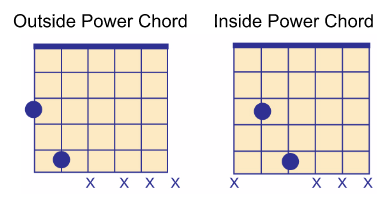
Guitarists in this genre often use the palm of their right hand to half-mute the strings while playing power chords. This technique gives power chords a unique sound and feel that’s become a staple within rock music. This technique can be used with or without distortion, but it’s almost always used with some sort of a sound effect foot pedal.
Power chords are only played on two or three strings, so most guitarists learn to mute unwanted strings with their left hand fingers. Power chords are easy to play, but this technique can be a difficult one to master.
Subgenres within rock
Like I mentioned before, simply referring to a genre of music as “rock” doesn’t accurately describe most music that has elements found in rock and roll. Here’s a brief list of some guitar playing styles commonly found in rock:
Metal- Bands like Slipknot and Mastodon are considered to be in the metal genre. Metal guitar music, which is a genre that now includes many sub genres of its own, is characterized by fast playing, drop D and C tuning, intricate riff solo playing and earth-shattering power chords.
Indie- Indie music is defined by a DIY philosophy that encourages innovation and an embrace of taking musical risks. Bands like Grizzly Bear, Death Cab For Cutie and Deerhunter are considered to be indie rock bands. Most indie rock guitarists don’t rely on power chords as much as their heavier counterparts. Indie guitar parts tend to be sparser and more harmonic than traditional rock bands.
Punk- The original punk ethos was an idea that non-musicians could rebel against the phoniness of commercialism found in popular music by taking up instruments as a form of protest. It’s hard to believe this is punk’s history when you hear some of the music in the genre being made today. The punk guitar playing style is heavy on blazingly fast, repetitive power chord changes with the occasional guitar solo thrown in every now and again. Everyone from The Ramones down to Blink 182 is affiliated with the punk genre in one way or another.
Folk and Country

Photo credit: / Elena Dijour Shutterstock.com
Folk and country guitar playing styles are played using both electric and acoustic guitars. In particular, the folk style frequently uses ornate acoustic fingerpicking as a staple element in its songs. Folk and country music as we know it today was largely developed in America, though some songs have their roots in countries like Great Britain, Europe and Africa. The guitar playing styles found in these genres are significantly more complicated and nuanced than more straightforward genres like punk, but they also pride themselves on being accessible to the masses and not pretentious.
Jazz
Jazz music features some of music’s most complicated and virtuosic guitar playing. The guitar playing style found in jazz is one that embraces a myriad of different chord voicings, an unconventional approach to rhythm and a penchant for unpredictability. Django Reinhardt, a jazz guitarist who pioneered the gypsy style of playing in the 30’s and 40’s, is widely regarded as being one of the greatest musicians of all time.
Not all jazz guitar playing is virtuosic, but most jazz music is typically defined by its use of complex harmonies. This means that if you’ll have to memorize a plethora of different extended chords and chord unconventional chord voicings if want to try your hand at some jazz guitar playing. The upside of this is that being a proficient jazz guitar player will most likely make you proficient in other genres as well.
Here’s an example of a major seventh chord typically found in jazz music. This chord voicing look similar to a barred chord, but it’s completely different. You’ll use your index to press down the 6th string note and mute unwanted open strings.
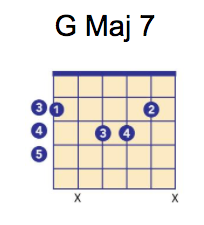
A universe of possibilities
The guitar playing styles I discussed in this article are just a few of the many exciting ways out there of playing the guitar. Talking about each and every one of them would turn this short article into a something the length of a few books. But in my opinion, music becomes truly great when it transcends genres and captivates listeners of every background. Good music borrows and melds together different playing styles to create something new and interesting, so it’s probably a good idea not to overthink what it means to play within the confines of just one genre. Rock, for example, began as the blending of many genres because the musicians behind it took a risk on trying something new. For more helpful articles about the world of music, check out the Musika Lessons blog.



